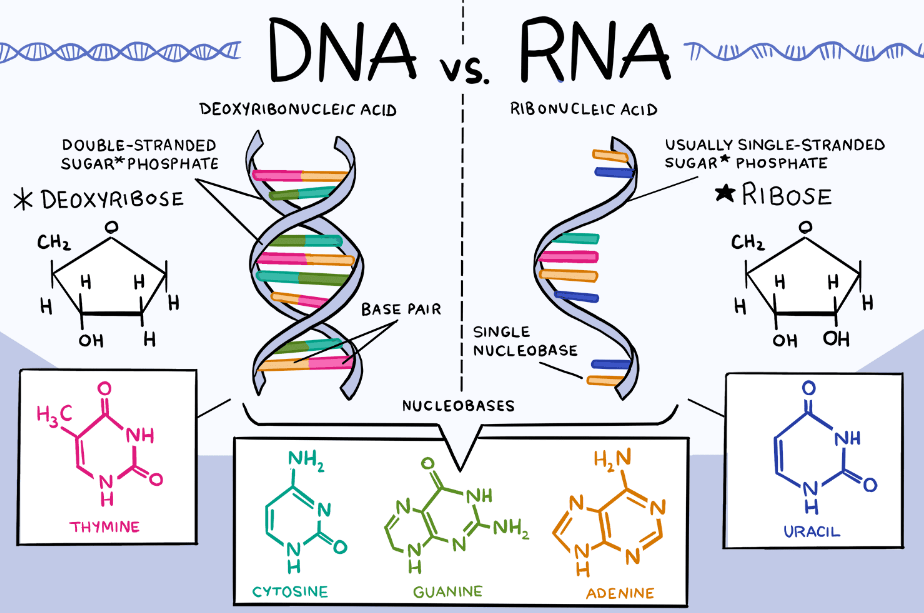The nucleic acids ribonucleic acid (RNA) and deoxyribonucleic acid (DNA) are among the most important molecules in cell biology, which are responsible for storing and transmitting genetic information in all living things. Despite the fact that they are both linear polymers containing sugars, phosphates, and bases, there are a few key differences between them.
Both molecules utilize these distinctions to cooperate and fulfill their essential functions. Here, we look at key differences between DNA and RNA. Let’s compare these two nucleic acids side-by-side before diving into the differences.

Table of Contents
What are the key differences between DNA and RNA?
Function
All genetic information is encoded in DNA, which is the blueprint for all biological life. And that’s only in the short term. Ultimately, DNA serves as a storage device, the blueprint of life being passed on from generation to generation. An RNA reader is used to decode this flash drive. The reading process is multi-step, and there are different RNAs for each step. The following sections describe the three main types of RNA in more detail.
What are the three types of RNA?
- Messenger RNA (mRNA) copies portions of genetic code, a process is known as transcription, and transports the copies to ribosomes, which are the cellular factories responsible for translating genetic code into proteins.
- These protein factories are supplied with amino acids, the basic building blocks of proteins, by transfer RNA (tRNA) in response to instructions coded into the mRNA. This protein-building process is called translation.
- Finally, Ribosomal RNA (rRNA) is an essential component of the ribosome factory, without which protein synthesis would not be possible.
Sugar
Both DNA and RNA are built with a sugar backbone, but the sugar in DNA is called deoxyribose (left in image); the sugar in RNA is simply ribose. The ‘deoxy’ prefix denotes that, whilst RNA has two hydroxyls (-OH) groups attached to its carbon backbone, DNA has only one and has an alone hydrogen atom attached instead. The extra hydroxyl group in RNA aids the process of converting genetic code into mRNAs which can be used to make proteins, while the deoxyribose sugar gives DNA more stability.
Bases
The nitrogen bases in DNA are the basic units of the genetic code, and their correct ordering and pairing are essential to biological function.
This code is made up of four bases: adenine (A), thymine (T), guanine (G), and cytosine (C). There are two pairs of bases in the double helix structure, A and T, and C and G. RNA doesn’t contain thymine bases, replacing them with uracil bases (U), which pair to adenine.
Structure
RNA’s single-stranded structure, though not as well known, may be due to some of the ubiquity of Francis Crick and James Watson’s DNA double helix (or should it be Rosalind Franklin’s DNA double helix?)
As mRNA and tRNA molecules pair during translation, RNA molecules can form double-stranded structures. In addition, DNA polymers are much longer than RNA polymers; the 2.3m-long human genome consists of 46 chromosomes, each of which is a single, long DNA molecule. RNA molecules, on the other hand, are much shorter4.
Location
Eukaryotic cells, including all animal and plant cells, house most of their DNA in the nucleus, where it exists in a tightly compressed form, called a chromosome. Since the DNA has been squeezed, it can be stored and transferred easily. In addition to nuclear DNA, some DNA is present in energy-producing mitochondria; tiny organelles are found free-floating in the cytoplasm, the cell area outside the nucleus.
RNA is found in three different locations. mRNA is made in the nucleus, with each mRNA fragment copied from its relative piece of DNA before leaving the nucleus and entering the cytoplasm. The fragments are then shuttled around the cell as needed, moved along by the cell’s internal transport system, the cytoskeleton. tRNA, like mRNA, is a free-roaming molecule that carries around the cytoplasm.
When it receives a signal from the ribosome, it will search for amino acid subunits in the cytoplasm and bring them to the ribosome to be built into proteins. As previously mentioned, rRNA is a component of ribosomes. Ribosomes are formed in an area of the nucleolus before being exported to the cytoplasm, where some ribosomes float freely. Other cytoplasmic ribosomes are bound to the endoplasmic reticulum, a membranous structure that helps process proteins and exports them from the cell.
